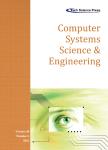Cognitive Radio Networks Using Intelligent Reflecting Surfaces
作者机构:Information Technology DepartmentSaudi Electronic UniversityRiaydhKingdom of Saudi Arabia
出 版 物:《Computer Systems Science & Engineering》 (计算机系统科学与工程(英文))
年 卷 期:2022年第43卷第11期
页 面:751-765页
核心收录:
学科分类:0810[工学-信息与通信工程] 0808[工学-电气工程] 0809[工学-电子科学与技术(可授工学、理学学位)] 08[工学] 0802[工学-机械工程] 0701[理学-数学] 0811[工学-控制科学与工程] 0812[工学-计算机科学与技术(可授工学、理学学位)]
主 题:Cognitive radio networks energy harvesting spectrum sensing throughput analysis
摘 要:In this article,we optimize harvesting and sensing duration for Cognitive Radio Networks(CRN)using Intelligent Reflecting Surfaces(IRS).The secondary source harvests energy using the received signal from node ***,it performs spectrum sensing to detect Primary Source PS *** PS activity is not detected,The Secondary Source SS transmits data to Secondary Destination SD where all reflected signals on IRS are in phase at *** show that IRS offers 14,20,26,32,38,44,50 dB enhancement in throughput using M=8,16,32,64,128,256,512 reflectors with respect to CRN without *** also suggested to add a second IRS between A and SS to increase the harvested *** use of 2 IRS with M1=8 reflectors in the first IRS and M2=8 reflectors in the second IRS offers 18 dB gain(respectively 32 dB)gain with respect to a single IRS with M2=8 reflectors(respectively without IRS).The use of 2 IRS with M1=16 reflectors in the first IRS and M2=8 reflectors in the second IRS offers 28 dB gain(respectively 42 dB)gain with respect to a single IRS with M2=8 reflectors(respectively without IRS).Our results are valid for Nakagami channels of fading figure *** also provide the throughput of IRS with energy *** have studied packet waiting time and total delay in the presence and absence or *** Signal to Noise Ratio(SNR)per bit equal to 0 dB,packet waiting time is 0.9 ms when there is no IRS and 0.5 ms when there is an IRS with M=8 *** SNR per bit equal to 0 dB,total transmission delay is 54 ms when there is no IRS and 1.5 ms when there is an IRS with M=8 *** show that the energy efficiency is larger when both harvesting and sensing durations are *** maximum of energy efficiency is 260 Mbit/s/Hz/J when harvesting and sensing durations are optimized while the maximum is 80 Mbit/s/Hz/J when harvesting and sensing durations are not optimized.



